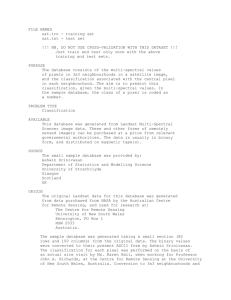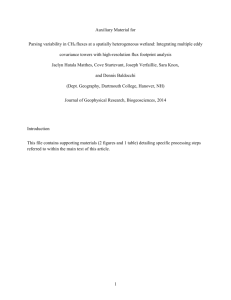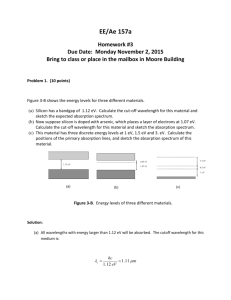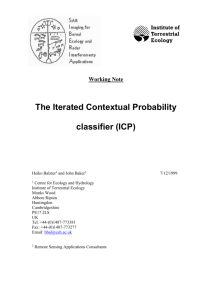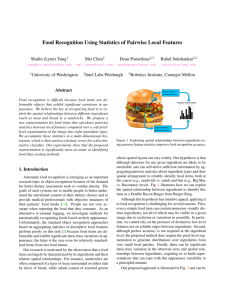Change detection and Time Series Analysis
advertisement
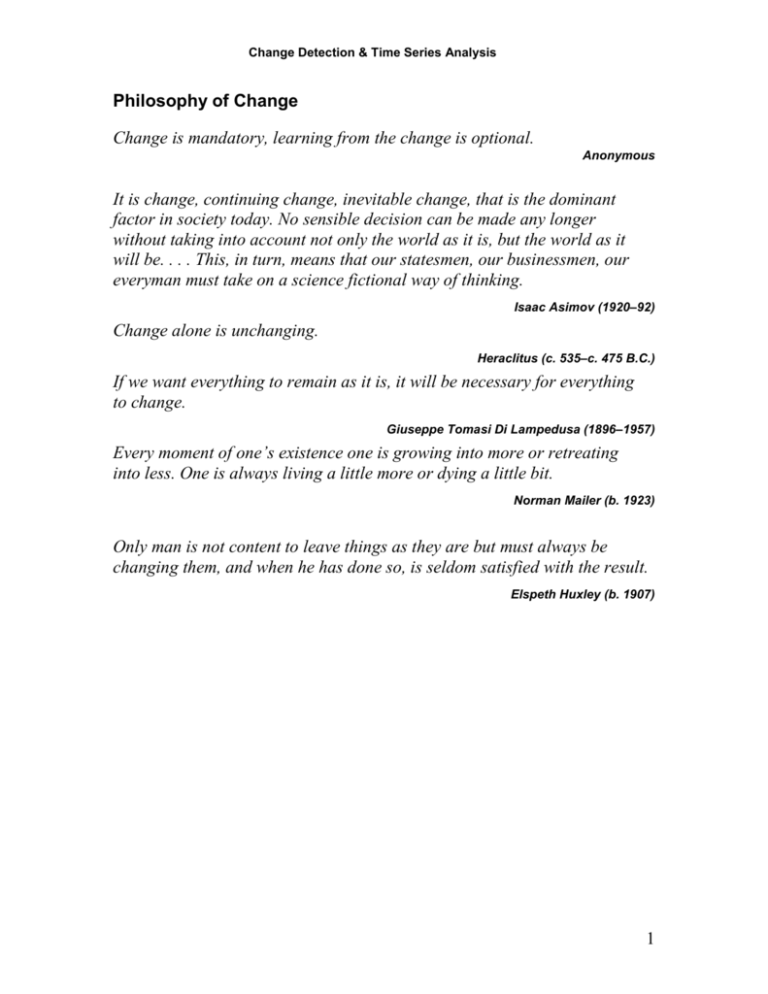
Change Detection & Time Series Analysis Philosophy of Change Change is mandatory, learning from the change is optional. Anonymous It is change, continuing change, inevitable change, that is the dominant factor in society today. No sensible decision can be made any longer without taking into account not only the world as it is, but the world as it will be. . . . This, in turn, means that our statesmen, our businessmen, our everyman must take on a science fictional way of thinking. Isaac Asimov (1920–92) Change alone is unchanging. Heraclitus (c. 535–c. 475 B.C.) If we want everything to remain as it is, it will be necessary for everything to change. Giuseppe Tomasi Di Lampedusa (1896–1957) Every moment of one’s existence one is growing into more or retreating into less. One is always living a little more or dying a little bit. Norman Mailer (b. 1923) Only man is not content to leave things as they are but must always be changing them, and when he has done so, is seldom satisfied with the result. Elspeth Huxley (b. 1907) 1 Change Detection & Time Series Analysis Change detection/TSA. What is it? Change detection refers to the difference in data between two dates pairwise image comparisons (e.g. deforestation from one summer to the next). Time Series Analysis (TSA) refers to the examination of change in data through time at more than two intervals - multiple image comparisons (e.g. deforestation and regrowth at one year intervals over a 10-year period). Analysis of Change is concerned with two basic types of data: Quantitative - differences in degree (continuous data ) e.g. DEM Qualitative - differences in kind (discrete data ) - e.g. landuse Techniques will tend to differ depending on whether the data is quantitative or qualitative pairwise (simple change) or time series comparisons are being made Change can occur in time, space, or both: 2 Change Detection & Time Series Analysis Change Detection - Why bother? Different reasoning tasks for developing space-time paths within a Spatio-Temporal Data Model Task Prediction Description Given a description of the world over some period of time, and the set of rules governing change, predict the world at some future time Description + rules prediction of potential future state Explanation Given a description of the world over some period of time and the rules governing the change, produce a description of the world at some earlier time Description + rules description of a past state Learning new rules Given a description of the world at different times, produce the rules governing change which account for the observed regularities in the world Description + observed states - rules Planning Given a description of some desired state of the world over some period of time and given the rules governing change, produce a sequence of actions that would result in a world fitting that description Description of potential future state + rules actions Wachowicz, Monica, Object-Oriented Design for Temporal GIS, Taylor & Francis, 1999. 3 Change Detection & Time Series Analysis Change Detection Analysis General data processing elements (steps) 1. Data Acquisition and Preprocessing Establish suitable study area Evaluating the data for cloud cover and general data quality Purchasing the data Creating mosaics, taking sub-areas, masking unwanted features 2. Geometric and Radiometric Corrections Geometric fidelity is particularly important for change detection since analysis is performed on a pixel-by-pixel basis (local operation) Spatial RMS errors should not exceed 0.5 pixel (image-to-image registration) Radiometric corrections must be made to account for differences in atmospheric effects (e.g. images might be selected that are weeks, months, years apart) and sensor properties (e.g. gain & offset, spectral range) 3. Data Normalization Select one image in the set as a reference and use radiometric normalization techniques to normalize the remaining images to the reference image 4. Change Detection Analysis Image differencing, image ratioing, image regression, PCA, CVA (Change Vector Analysis), (SMA) Spectral Mixture Analysis 5. Accuracy Assessment Error / Confusion / Contingency matrix creation and analysis Kappa statistic 6. Final Product Generation Maps and reports of change From Ross S. Lunetta, "Applications, project formulation, and analytical approach", in Remote Sensing Change Detection, Ross S. Lunetta and Christopher D. Elvidge (ed.), Ann Arbor Press, 1998 4 Change Detection & Time Series Analysis Overview of Change Detection Analysis techniques 4. Change Detection Analysis 4.1. Pairwise Image Comparison (Change detection) 4.1.1. Quantitative Data 4.1.2. Qualitative Data 4.1.3. Spectral Mixture Analysis (SMA) 4.2. Multiple Image Comparisons (Time Series Analysis) 4.2.1. Image Deviation 4.2.2. Change Vector Analysis 4.2.3. Time Sequencing & Profiles 4.2.4. Principle Components Analysis 5. Accuracy Assessment Problems with Change Detection 5 Change Detection & Time Series Analysis 4. Change Detection Analysis 4.1. Pairwise Image Comparison (Change detection) 4.1.1. Quantitative Data 4.1.1.1. 1. 2. 3. 4. Image differencing Image_C = Image_A - Image_B Then threshold Image_C to classify "change" and "no change" pixels Check classification accuracy with error (contingency) matrix Repeat 2 and 3 until maximum accuracy is achieved. Ground truth is required to create an error matrix as shown below: 6 Change Detection & Time Series Analysis 4.1.1.2. Image ratioing Image C = Image_A / Image_B Image differencing is for measuring differences in an absolute sense. Image ratioing is used for measuring differences in a relative sense. For example, if biomass level differences were measured and for one group of pixels, the biomass levels increased from 5 to 10 and another group of pixels, the increase was from 95 to 10, then the absolute difference between the two sites is 5 (ie. 10 - 5 = 5 and 100 - 95 = 5). However, the former represents a 100% increase and the latter a 5% increase. More weight is given to values as they approach 0. Using the above numbers: 10/5 = 2 vs. 100/95 = 1.05 Three important considerations: 1. Must use ratio scale data (i.e. must be a"true" zero) 2. Division by zero is an error. A small number must be added to the numerator and denominator. Evaluate effects by looking at extreme values, i.e. find maximum numerator and minimum denominator add small number to both and divide add double small number to both and divide assess whether small increment will affect your analysis 3. The resulting numeric scale is neither symmetric or linear so thresholding is difficult. For example, 1 is twice as big as 0.5 but the difference is 0.5. 2 is twice as big as 1 but the difference is 1.0. Solution: Take the natural logarithm of the ratio; X 0.5 1 2 ln(X) -0.693 0 +0.693 7 Change Detection & Time Series Analysis 4.1.1.3. Image regression Regression coefficient provides a measure of the statistical correlation between two images. However, regression assumes representative sample of independent measurements. Raster imagery violate this basic assumption due to high autocorrelation of adjacent pixels. If valid regression coefficients, degrees of freedom, etc. are required, then the following procedure will more accurately calculate these statistical parameters. 1. 2. 3. 4. 5. Use AUTOCORR to calculate spatial autocorrelation Use contract to sample the data at wider spacing Repeat 1 and 2 for wider spacings (coarser resolutions) Plot autocorrelation vs. sample spacing Graph will indicate a sample spacing with sufficiently low autocorrelation. 6. Run regression on images with sample spacing indicated in 5. Regression can also be used for Radiometric Correction. Assume simple difference or log transformed ratio image with value of 0 means no change. This may not be the case! There are cases where images must be calibrated to each other. Comparison of uncalibrated images will not be valid. For example, gain and offset of a satellite sensor may be different for two images taken a year apart or atmospheric conditions might be different. Image regression computes gain and offset values to compensate for such affects (radiometric correction). 8 Change Detection & Time Series Analysis 4.1.1.4. Change Vector Analysis Assume pixel values for two different bands (images) change from one time to another as shown in the following graph. It is possible to characterize the change with the distance and direction images. The values of the pixels in these images will help the analyst to visualize the change in multi-band space. D X 2 X 1 2 Y2 Y1 2 Y Y Angle tan 1 2 1 X 2 X1 where, X1, X2 = pixel value of band1 at time 1 and time 2 respectively Y1, Y2 = pixel value of band2 at time 1 and time 2 respectively 9 Change Detection & Time Series Analysis 4.1.2. Qualitative Data 4.1.2.1. Cross-classification Cross-classification maps the logical AND of all possible combinations of categories on two maps. This is summarized with a cross-classification matrix as shown above. In Idrisi, the CROSSTAB command produces a cross-classification image. Analysis of the crosstabulation table focuses on the elements along the diagonal as compared with the off-diagonal elements. The per-category Kappa tabulation (discussed later) can be used to quickly gain an appreciation of which categories are the major ones that have been changed, and the nature of that change. 10 Change Detection & Time Series Analysis 4.1.3. Spectral Mixture Analysis (SMA) The reflected spectra measured by a sensor, such as Landsat TM, can be modelled as the sum of the "pure" spectra within the instantaneous field of view (IFOV) weighted by the areal proportion of each material. The "pure" spectra are called endmembers and the process of solving for endmember fractions is called linear Spectral Mixture Analysis. This figure shows a schematic of a TM Pixel containing three feature types: soil, vegetation, and vegetation shadow. The middle graphs show the reflectance spectra of the three feature types. The graph at the bottom of shows the reflectance spectra of the pixel. This figure shows the three endmember mixture plotted on a TM4 vs. TM3 scatter diagram (NIR vs. Red ) 11 Change Detection & Time Series Analysis The figure below shows the steps used in Multitemporal SMA. 12 Change Detection & Time Series Analysis By decomposing the image data into spectral fractions of "pure" spectra, a decision tree can be created to classify the images based on changes in spectral fractions. Changes in pixel spectra with time can be tabulated in transition matrices for analysis. 13 Change Detection & Time Series Analysis 4.2. Multiple Image Comparisons (Time Series Analysis) Fewer methods exist for multiple image comparisons relative to pairwise comparisons. Helps examine (a) trends or, (b) anomalies from a general trend. One of the major problems is that the time of images capture is not synchronized with the variability in the phenomenon measured. 4.2.1. Image Deviation Difference relative to a long term average. Difference between any image in the series and the long term average can be analyzed. Adding all the "difference" images would provide an image of the most "dynamic" areas on in the image. 4.2.2. Change Vector Analysis Computationally similar to pairwise analysis. There is often a strong correlation between the variability in the measured phenomenon and the distance component of the change vector. 4.2.3. Time Sequencing & Profiles Time sequencing refers to the sequential display of images. In Idrisi, this is achieved by using the Media Viewer to create AVI files. Time profiles involves analysing the behaviour of a descriptive statistic (e.g. min, mean, max, standard deviation, etc.) for selected sites (in Idrisi, up to 15 sites can be monitored) for series of images through time. 14 Change Detection & Time Series Analysis 4.2.4. Principle Components Analysis PCA for a series of images through time. First PC has areas of similarity, the minor components highlight areas of change. The series can be examined as a whole and change can be investigated in a progressive manner from most significant to least significant (PC2, 3, etc.). 5. Accuracy Assessment Change Detection Matrix for a three-feature classification Change Classified NC T1 A B C A A B B C C T2 A B C B C A C A B No Change (NC) A B C A B C 1 3 3 3 1 3 3 3 1 4 4 4 4 4 4 4 4 4 4 4 4 4 4 4 4 4 4 Reference Change A A B B B C A C 5 5 5 5 5 5 5 5 5 5 5 5 2 6 6 6 6 2 6 6 6 6 2 6 6 6 6 2 6 6 6 6 6 6 6 6 C A 5 5 5 6 6 6 6 2 6 Summary of possible combinations of change/no change represented in a change detection error matrix Classified Reference True Change True No Change Correct Change Correct No Change Incorrect Change Incorrect No Change No error (2) Not Possible Not Possible No error (1) Classification error(6) False Positive(4) False Negative (2) Classification error(3) 15 C B 5 5 5 6 6 6 6 6 2 Change Detection & Time Series Analysis 16 Change Detection & Time Series Analysis Producer and User accuracy User accuracy: Percentage of pixels that were predicted to be a cover type that actually were that cover type according to the "ground truth" (Rows) Producer accuracy: Percentage of pixels that were assumed to be true and reflect errors of omission (Columns) Example provided in the following tables 17 Change Detection & Time Series Analysis Problems with Change Detection 1. Many techniques rely on thresholding but there are no clear guidelines on how these thresholds should be set. 2. Often there is a poor relation between the temporal resolution of the remotely sensed data and temporal variability of the phenomena. 3. Many techniques rely on standard statistical techniques that do not take into account autocorrelation. 4. There are few options for Change Detection Analysis given more than two images (e.g. TSA) 18


